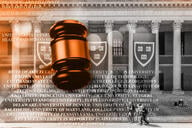You have /5 articles left.
Sign up for a free account or log in.
Today is the opening day of the much-anticipated court challenge to Harvard’s treatment of Asian American applicants in its admissions process. Students for Fair Admissions, Inc. v. President and Fellows of Harvard College et al. goes to trial this morning in U.S. District Court in Boston, nearly four years after it was originally filed.
This case has had all the buildup of a championship fight. It wouldn’t be surprising to have “oyez, oyez” replaced by Michael Buffer intoning “Are you ready to rumble?” We’ve had dueling motions from both sides for summary judgment denied by Judge Allison Burroughs, and so here we are, ready for the main event.
But is this really the main event? Regardless of the outcome of this trial, is the next “affirmative action Armageddon” (to channel Muhammad Ali) ultimately going to be decided by a Supreme Court with Brett Kavanaugh tagging in for Anthony Kennedy?
It is nevertheless hard to ignore the symbolic significance of this case. In the Bakke case, the first dealing with race-based affirmative action in college admission considered by the Supreme Court 40 years ago, Justice Lewis Powell held up Harvard’s holistic admissions process as the gold standard for consideration of race as one factor among many. Now the Harvard process, the foundation for Powell’s position that promoting diversity is the only justification for race-based affirmative action, is itself under attack.
In May 2015 I was interviewed for NPR’s All Things Considered. I was contacted based on an article I had written for Eric Hoover’s "Head Count" blog in The Chronicle of Higher Education where I posed a question I have written about several times: “Are we measuring the right qualities in the admissions process?”
During my preinterview with the producer, I was told the interview would be about the changing admissions landscape, with “grit” and how one assesses it as a possible topic. I prepared to talk about that topic, so was thrown off when the first question asked by host Arun Rath was “Do Asian American applicants face an unlevel playing field?”
I shouldn’t have been surprised. To be fair, the producer in passing had mentioned racial preferences as a possible topic, and in the whirl of commencement week activities at my school I had missed a news story a couple of days before that a coalition of 64 organizations had filed a complaint with the U.S. Department of Education’s Office for Civil Rights alleging that Harvard discriminates against Asian American applicants in the admissions process.
I have since written several times about this case, and am not sure I have anything new to say (critics may say that’s true of many subjects I write about). This column has always tried to look at the broader questions and assumptions that undergird college admission, and here are some of those relevant to this case that may or may not come up in the trial itself.
Are Asian Americans underrepresented at Harvard? The answer depends on your perspective and frame of reference. The percentage of Asian American students in the student body at Harvard (20 percent) is higher than the percentage in the population at large (5-6 percent), but lower than the percentage in the Harvard applicant pool. The argument made by the plaintiffs is that Asian Americans would “earn” a higher number of places if Harvard considered academic merit alone, and as evidence cite the experience of universities in the University of California system and places like Caltech where racial preferences are outlawed and the percentage of Asian American students is much higher.
Is this case a challenge to race-based affirmative action or selective admission? The answer is both. Clearly the raison d’être for the group Students for Fair Admissions and its founder, Edward Blum, is attacking the use of race-based preferences in college admission, and there are cynics (and those not that cynical) who suspect that Blum and SFFA have embraced the Asian American cause out of convenience rather than conviction.
The seeds for this case go back at least as far as the Bakke case, where Harvard’s use of race as one factor among many in admission was singled out by Justice Powell. In a separate opinion in the same case, Justice Harry Blackmun noted that the Harvard plan “may accomplish covertly what (the University of California at) Davis concedes it does openly.”
The larger threat may be to selective admission itself. There are several components of selective admission that combine to make it mysterious and hard for an outsider to evaluate.
The first of these is holistic admission, where admission decisions are made based on the whole of a student’s application rather than some formula. It is clear from discussion of this case that many people want to believe that Harvard must have a secret formula.
In a hyperselective environment where 5 percent of applicants are admitted, there is no combination of qualities that guarantees admission. But holistic admission can mean that different candidates are admitted for nonacademic reasons ranging from special talents to diversity to knowing the right people. Students who don’t fall into any of those categories are at a huge disadvantage. Holistic admission can also provide a shroud that protects institutions from criticism of individual decisions.
Coupled with holistic admission is the emphasis on admitting not individuals but a class. Students are admitted to Harvard and similar institutions not because they are deserving but because they also contribute to helping achieve institutional goals ranging from academic profile to diversity to revenue.
The question is how much sculpting takes place to achieve the class composition. The percentage of students in the freshman class at Harvard from Asian American and other ethnic groups is remarkably consistent from year to year. Is that coincidence or evidence of racial balancing?
Is it time to get rid of personal ratings? Applicants to Harvard are assigned a rating of one to four in four areas -- academic, extracurricular, athletic and personal. The first two make sense, and the athletic rating is presumably a way to identify and help recruited athletes in the process. One of the most eye-opening moments from the motions filed this summer by both sides was evidence that Asian Americans are systematically rated lower on the personal rating than other applicants. Is that evidence of implicit bias? More important, should colleges try to rate students on things like integrity, sense of humor, kindness and helpfulness based on what’s found in an application?
Could other kinds of preferences be threatened? Will the issues raised in this trial lead to a broader discussion about preferences for legacies and athletes, both of which tend to advantage white applicants with modest academic records? Racial preferences are more defensible than either of those. Are they next, and will Students for Fair Admissions want to end or defend them?
Finally, can we end once and for all the claim that Harvard’s treatment of Asian Americans today mirrors its treatment of Jewish applicants a century ago? That may be effectively inflammatory spin for those wanting to end race-based preference in college admission, but it’s not fair to anyone involved, and it’s not true.
Are we ready to rumble?




